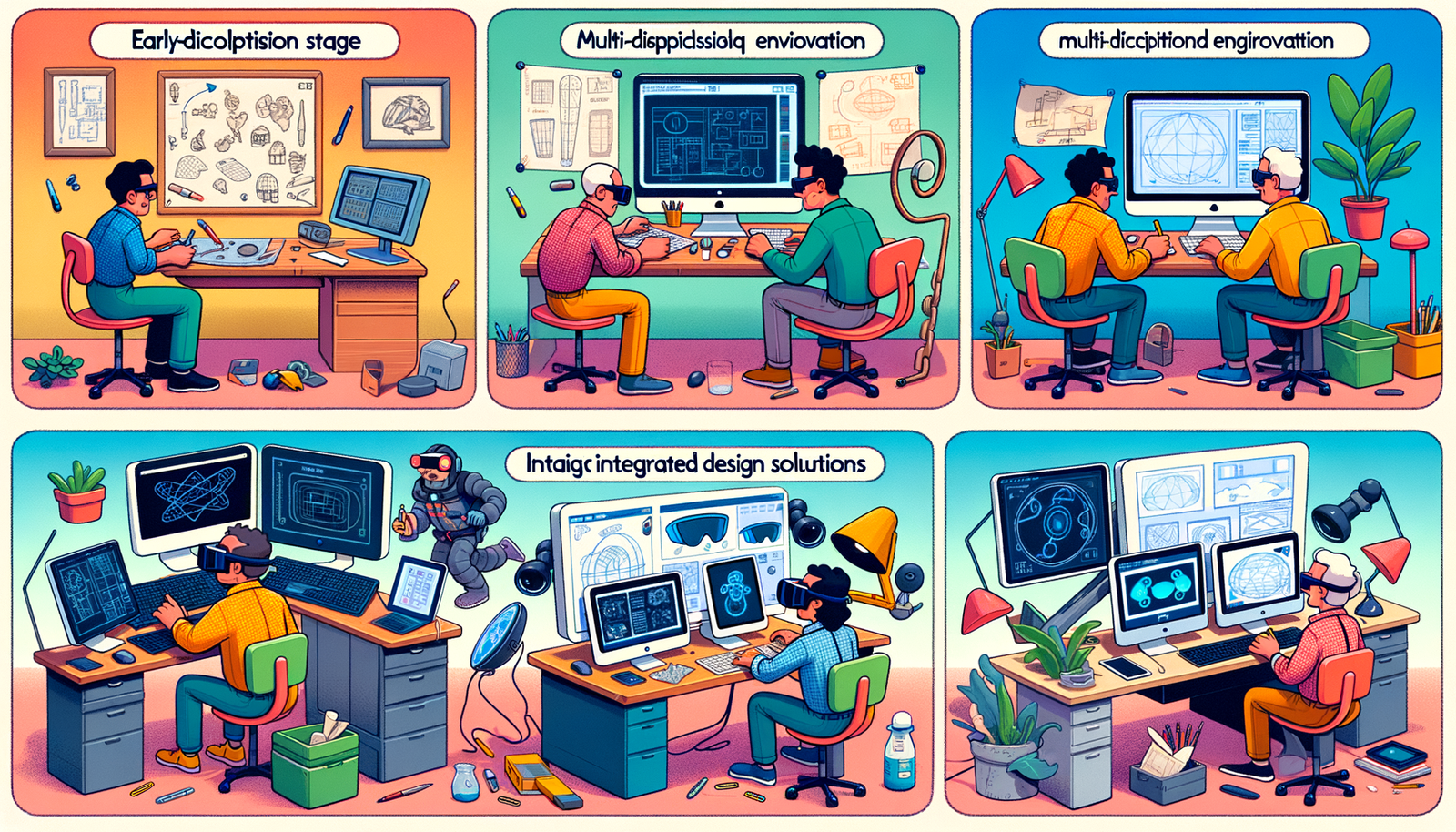Your Cart is Empty
Customer Testimonials
-
"Great customer service. The folks at Novedge were super helpful in navigating a somewhat complicated order including software upgrades and serial numbers in various stages of inactivity. They were friendly and helpful throughout the process.."
Ruben Ruckmark
"Quick & very helpful. We have been using Novedge for years and are very happy with their quick service when we need to make a purchase and excellent support resolving any issues."
Will Woodson
"Scott is the best. He reminds me about subscriptions dates, guides me in the correct direction for updates. He always responds promptly to me. He is literally the reason I continue to work with Novedge and will do so in the future."
Edward Mchugh
"Calvin Lok is “the man”. After my purchase of Sketchup 2021, he called me and provided step-by-step instructions to ease me through difficulties I was having with the setup of my new software."
Mike Borzage
Design Software History: Evolution of Multi-Disciplinary Design Environments: From Early Innovations to Modern Integrated Software Solutions and Future Trends in Collaborative Design Practices
March 28, 2025 7 min read


Introduction to Multi-Disciplinary Design Environments
Multi-disciplinary design environments are collaborative platforms that integrate various disciplines involved in the design process, enabling professionals from different fields to work together seamlessly. These environments are significant because they bridge the gaps between disparate domains like engineering, architecture, and product design, fostering a collaborative ecosystem where ideas and data can be shared efficiently. In today's complex project landscapes, the integration of multiple disciplines is crucial for the successful realization of sophisticated designs. By providing a unified platform, multi-disciplinary design environments facilitate better communication, reduce errors, and accelerate the design process. They allow for the synchronization of various aspects of a project, ensuring that all stakeholders are aligned and that the final product meets the necessary specifications and standards. The role these environments play in facilitating collaboration cannot be overstated; they are the backbone of modern design practices where cross-disciplinary cooperation is essential. With the advent of digital technologies, these platforms have evolved to offer real-time collaboration, enabling teams spread across different geographical locations to work together as if they were in the same room. This level of integration and collaboration leads to more innovative solutions and helps organizations stay competitive in a rapidly changing market.
Early Developments in Multi-Disciplinary Design
The journey towards multi-disciplinary design environments began with key milestones that set the foundation for collaborative design practices. One of the most noteworthy contributions came from Ivan Sutherland with the development of Sketchpad in 1963. Sketchpad was a revolutionary computer program that allowed users to interact directly with a graphical interface, laying the groundwork for computer-aided design (CAD) systems. It introduced the concept of object-oriented programming and graphical manipulation, which were critical in enabling different disciplines to visualize and modify designs interactively. Sketchpad's influence extended beyond its immediate applications; it inspired generations of software that embraced interactive design and user engagement. The principles established by Sutherland's work became integral in developing systems that support collaboration between architects, engineers, and designers. As technology progressed, these early developments paved the way for more sophisticated tools that could handle complex calculations and simulations required by various disciplines. The emphasis on creating intuitive interfaces and enabling real-time collaboration was a significant shift from the siloed approaches of the past. This period marked the beginning of a new era where cross-disciplinary integration started to become a focal point, leading to the development of platforms that could support the diverse needs of different professionals within a single environment.
Advent of Integrated Software Solutions
The transition from siloed design approaches to integrated software solutions marked a significant evolution in the design industry. As projects grew in complexity, the need for platforms that could handle multiple facets of design became apparent. Software solutions like Autodesk Revit and Dassault Systèmes CATIA emerged as pioneers in promoting cross-disciplinary collaboration. Autodesk Revit, introduced in 2000, was designed specifically for Building Information Modeling (BIM), allowing architects, engineers, and construction professionals to work within a single, unified model. This integration facilitated better coordination and reduced the likelihood of errors during the construction process. Similarly, Dassault Systèmes CATIA provided a comprehensive platform for product design and engineering, supporting industries ranging from aerospace to automotive. CATIA enabled different teams to work on various components of a product simultaneously, ensuring consistency and compatibility across the design. The impact of these platforms was profound; they not only improved efficiency but also enhanced innovation by enabling teams to experiment with designs in a virtual environment. The integration of various disciplines within these software solutions meant that design considerations from all relevant fields could be incorporated early in the process, leading to more holistic and optimized outcomes. This era saw the blurring of lines between disciplines, with software acting as the unifying force that brought together diverse expertise into a cohesive workflow.
Technological Enablers
Advancements in technology have been the cornerstone of multi-disciplinary design environments. Key technological enablers include:
- Geometric modeling: Allowed for the creation of complex shapes and structures, providing a mathematical foundation for representing objects in three dimensions.
- Parametric design: Introduced the ability to define key parameters that could be adjusted to automatically alter the design, giving designers unprecedented flexibility and control.
- Increased computational power: Enabled the processing of large datasets and complex calculations required in multi-disciplinary projects.
- Advances in cloud computing: Offered scalable resources that support collaborative work environments, enabling real-time data sharing and collaboration.
Key Software and Tools
Several prominent software tools have become instrumental in facilitating multi-disciplinary design. Siemens NX is one such tool that offers a comprehensive suite for product design, engineering, and manufacturing. It integrates various aspects of the design process, from conceptualization to simulation and manufacturing, within a single platform. Siemens NX supports synchronous technology, allowing for flexible modeling and easy modifications, which is essential in a collaborative environment where changes are frequent. Another key player is PTC Creo, a scalable suite of product design software that enables teams to create, analyze, and share designs seamlessly. PTC Creo's parametric modeling capabilities and simulation tools help in optimizing designs and reducing time to market. These tools are designed to support collaboration by providing features that allow simultaneous work on different aspects of a project, ensuring that all team members are working with the most up-to-date information. They also support interoperability with other software, which is critical in a multi-disciplinary context where different teams may use specialized tools. By integrating different aspects of design, engineering, and manufacturing, these software solutions help break down barriers between disciplines and foster a more collaborative and efficient design process. They provide the necessary infrastructure for teams to work together effectively, leveraging each other's strengths to produce superior outcomes.
Current Challenges in Implementation
Despite the advancements and benefits of multi-disciplinary design environments, there are still significant challenges in their implementation. Some of the primary barriers include:
- Interoperability issues: Teams often use specialized software tailored to their discipline, and integrating these tools can be complex. Discrepancies in data formats and standards can lead to information loss or misinterpretation, compromising the integrity of the design.
- Data management: Handling large amounts of data securely and efficiently requires robust systems and protocols. Ensuring that all team members have access to the necessary data while maintaining appropriate security measures is a delicate balance.
- Aligning workflows and methodologies: Each discipline may have its own processes and terminologies, making reconciliation difficult. Collaboration requires not only technological integration but also cultural shifts within organizations to promote openness and communication.
- Training and proficiency: Team members need to be skilled in using integrated tools effectively. Providing adequate training is essential to maximize the benefits of these environments.
- Scalability and performance: Dealing with large, complex projects poses challenges in terms of the scalability and performance of the environments.
Future Trends and Innovations
The future of multi-disciplinary design environments is poised to be shaped by several emerging trends and innovations. The integration of Artificial Intelligence (AI) and machine learning into design processes is one such trend that promises to revolutionize the way teams collaborate and create. AI can assist in automating routine tasks, optimizing designs based on vast datasets, and even predicting potential issues before they arise. Machine learning algorithms can analyze patterns and outcomes from previous projects to provide insights and recommendations, enhancing decision-making and efficiency. Another significant development is the use of Virtual Reality (VR) and Augmented Reality (AR) technologies. These immersive technologies allow team members to experience designs in a three-dimensional virtual space, improving understanding and communication of complex concepts. VR and AR can facilitate better stakeholder engagement by providing realistic visualizations of projects before they are built. Additionally, the concept of digital twins is gaining traction. A digital twin is a virtual replica of a physical entity, which can be used for simulation, analysis, and optimization. Digital twins enable real-time monitoring and testing of designs under various conditions, leading to more robust and reliable outcomes. The combination of these technologies is set to enhance collaboration further by providing more intuitive and powerful tools for designers and engineers. As these innovations continue to develop, they will play a crucial role in shaping the future of multi-disciplinary collaboration, making it more efficient, effective, and innovative.
Conclusion
Multi-disciplinary design environments are integral to the modern design landscape, providing the framework for collaboration across various fields. They have evolved significantly from early developments like Ivan Sutherland's Sketchpad to today's sophisticated integrated software solutions like Autodesk Revit, Dassault Systèmes CATIA, Siemens NX, and PTC Creo. These environments have been enabled by advancements in geometric modeling, parametric design, computational power, and cloud computing. While challenges such as interoperability, data management, and aligning workflows persist, ongoing innovations in AI, machine learning, VR, AR, and digital twins offer promising solutions. The significance of multi-disciplinary environments lies in their ability to bring together diverse expertise, fostering innovation, efficiency, and sustainability in design practices. As organizations continue to adopt and develop these environments, they stand to benefit from more collaborative and effective design processes. The future of multi-disciplinary design is bright, with continued advancements poised to revolutionize the way we approach complex projects. By embracing these environments and addressing the existing challenges, we can look forward to a new era of design that is more efficient, sustainable, and revolutionary, ultimately leading to groundbreaking and impactful outcomes that shape the world around us.
Also in Design News

Cinema 4D Tip: Matrix-Driven Instancing for High-Performance Scattering
December 20, 2025 2 min read
Read More
V-Ray Tip: V-Ray Anisotropy Techniques for Brushed Metals and Hair
December 20, 2025 2 min read
Read More
Revit Tip: Revit Nested Tagging: Shared Nested Families and Roll-Up Parameters
December 20, 2025 2 min read
Read MoreSubscribe
Sign up to get the latest on sales, new releases and more …


